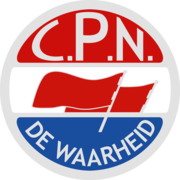Communist Party of the Netherlands Communistische Partij Nederland | |
|---|---|
 | |
| Abbreviation | CPN |
| Founded | 14 February 1909 |
| Dissolved | 15 June 1991 |
| Youth wing | General Dutch Youth League |
The Communist Party of the Netherlands (CPN) was a Dutch communist party. The party was founded in 1909
as the Social-Democratic Party (SDP). The founders of the CPN maintained orthodox marxist views and expected a proletarian revolution. They opposed the leadership of the Dutch SDAP, who were oriented towards more a revisionist ideology and a parliamentary and reformist political strategy.
After the Russian Revolution, the party adopted the name Communist. With the departure of a left-wing group, the party adopted Marxism–Leninism, following the Comintern. The party advocated the overthrow of the state by a vanguard party, which would lead the country towards socialism. The party remained faithful to the USSR's version of Marxism–Leninism during the 1920s, when Trotsky's interpretation became an important ideological competitor of Joseph Stalin's in Western Europe. This led to a split when a group around a prominent ally of Trotsky, Henk Sneevliet, left the party to form the Revolutionary Socialist Party.
World War II and aftermath
Tn May 15 1940, immediately after the Nazi occupation, the party decided to organize an underground movement. In July 1940, the occupation force banned the CPN; the party continued illegally. Together with the much smaller anti-Stalinist communist party RSP, it founded a resistance movement. It published a resistance newspaper called De Waarheid (The Truth). Both took part in the February Strike in 1941, the largest act of resistance in the Netherlands.
After the war, the party was led by Paul de Groot, who had a strong grip on the party's organization. In 1945 the CPN was offered a single minister's post in the Dutch transition cabinet, mainly because of the CPN's role in the Dutch resistance. The CPN refused as their single minister would be effectively co-opted by an anti-revolutionary majority in the cabinet. In the 1946 Dutch general election, the party obtained nearly 11% of the vote and 10 seats in the Dutch Parliament. The following period was characterized by decreasing popularity for communism, smear campaigns and methodical isolation of the CPN by reactionaries.
Late 20th century
In the 1960s the party did not choose sides in the conflict between the People's Republic of China and the USSR. Nevertheless, a Maoist group, called the Communist Unity Movement of the Netherlands split from the Party. In the 1970s and 1980s the Party began to move away from its Marxist-Leninist roots and began to fall to Eurocommunism.
| Part of a series on |
| Communist parties |
|---|
The CPN and eventually merged with the Pacifist Socialist Party (Netherlands), the Political Party of Radicals (Netherlands) and the Evangelical People's Party (Netherlands) in 1991, forming the GreenLeft (Netherlands). Members opposed to the merger founded the New Communist Party of the Netherlands.